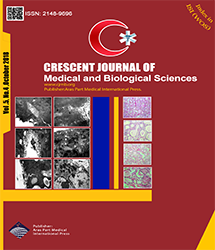
| Original Article | |
| Cardioprotective Effects of Curcumin Co-treatment in Rats With Establishing Chronic Variable Stress Stereology Study | |
| Masoomeh Mohamadpour1, Leila Kamali Dolatabadi2, Ali Soleymani3, Maryam Mohsenkia4, Roholla Gazor5, Hassan Moladoust6, Elham Aliabadi7, Sara Sayad Fathi8, Ebrahim Nasiri9 | |
| 1Neuroscience Research Center, School of Advanced Medical Sciences and Technologies, Iran University of Medical Sciences, Research company of Rayan Extreme Development of Enterpreneurs, Tehran, Iran 2Department of Neuroscience, School of Advanced Medical Sciences and Technologies, Shiraz University of Medical Sciences, Shiraz, Iran. Alzahra Research Institute, Isfahan University of Medical Sciences, Isfahan, Iran 3Dezful University of Medical Sciences, Dezful, Iran 4Islamic Azad University of Tehran Medical Branch, Tehran, Iran 5Department of Anatomical Sciences, School of Medicine, Guilan University of Medical Sciences, Rasht, Iran 6Department of Biochemistry and Medical Physics, School of Medicine, Cardiovascular Research Center, Heshmat Hospital, School of Medicine, Guilan University of Medical Sciences, Rasht, Iran 7Anatomy Department, School of Medicine, Shiraz University of Medical Sciences, Shiraz, Iran 8Department of Anatomical Sciences, Cellular and Molecular Research Center, School of Medicine, Guilan University of Medical Sciences, Rasht, Iran 9Department of Anatomical Sciences, Cellular and Molecular Research Center, School of Medicine, Guilan University of Medical Sciences, Rasht, Iran |
|
|
CJMB 2018; 5: 306-311 Viewed : 20214 times Downloaded : 6195 times. Keywords : Cortisol, RLX, Oxytocin, CVS, CUR |
|
| Full Text(PDF) | Related Articles | |
| Abstract | |
Objectives: Prolonged and recurrent exposure to chronic variable stress (CVS) may lead to cardiovascular dysfunction. It is a basic cause of heart failure. The aim of current study was to determine the effect of curcumin (CUR) on the treatment of cardiac dysfunction in rats with established CVS. Materials and Methods: Thirty-five adult male Sprague-Dawley rats were divided into 3 groups as control, CVS, CVS+CUR (100 mg/kg/d dissolved in 0.5 mL of distilled water). All of the control animals and half of the animals in CVS and CVS+CUR groups were sacrificed after 15 days and the rest of animals were allowed to recover for 50 days. The relaxin (RLX), cortisol, adrenocorticotropic hormone (ACTH), oxytocin serum levels, and heart stereological structure were evaluated. Results: Significant deviations from the normal range occurred in RLX, cortisol, ACTH, and oxytocin serum levels in CVS and CVS + recovery groups compared to the control rats (P < 0.01). Furthermore, weight and heart weight, volume of the hearts and ventricles, total number of the nuclei reduced, and also volume of the connective tissue and diameter of the total vessels increased in the CVS animals in comparison to the control ones (P < 0.01). These parameters changed to a lesser extent in CVS+CUR animals compared to the CVS rats with or without a recovery period (P < 0.01). Conclusions: Findings of this study suggested that CUR might have a therapeutic potential for heart structure and function following the established CVS by regulation of stress and cardiovascular-related hormones and outcomes related to the change of this hormone. |
Cite By, Google Scholar
Google Scholar
PubMed
Online Submission System
 CJMB ENDNOTE ® Style
CJMB ENDNOTE ® Style
 Tutorials
Tutorials
 Publication Charge
Medical and Biological Research Center
About Journal
Publication Charge
Medical and Biological Research Center
About Journal
Aras Part Medical International Press Editor-in-Chief
Arash Khaki
Deputy Editor
Zafer Akan


















